Recovery of End-of-Life Building Materials: Thermal Decomposition and Phase Transformation of Chrysotile in Asbestos-Containing Fiber Cement Boards
Abstract
1. Introduction
2. Materials and Methods
2.1. Sample Collection and Preparation
2.2. Analytical Techniques
2.2.1. Initial Asbestos Quantification
2.2.2. Scanning Electron Microscope (SEM)
2.2.3. Thermogravimetric Analysis (TGA)
2.2.4. X-Ray Diffractometry Analysis (XRD)
2.2.5. Sample Milling
2.3. Experimental Protocol
2.4. Limitations of Techniques
2.5. Ethical and Environmental Considerations
3. Results
3.1. Overview of Research Scheme
3.2. Initial Asbestos Content
3.3. Particle Size Distribution
3.4. SEM Analysis
3.4.1. Sample A
3.4.2. Sample B
3.4.3. Sample C
3.4.4. Sample D
3.5. Thermogravimetric Analysis
3.6. SEM-EDS Analysis
3.6.1. Sample A
3.6.2. Sample B
3.6.3. Sample C
3.6.4. Sample D
3.7. XRD Analysis
3.7.1. Sample A
3.7.2. Sample B
3.7.3. Sample C
3.7.4. Sample D
3.7.5. Summary of XRD Analysis
4. Discussion
5. Conclusions
Supplementary Materials
Author Contributions
Funding
Data Availability Statement
Acknowledgments
Conflicts of Interest
References
- Paolini, V.; Tomassoli, E.; Segreto, M. Advances in asbestos waste management: A review of recycling and reuse strategies. Waste Manag. 2023, 171, 234–245. [Google Scholar] [CrossRef]
- Ginga, C.P.; Ongpeng, J.M.C.; Daly, M. Circular economy in construction: A systematic review of sustainable practices. Sustainability 2023, 15, 3289. [Google Scholar] [CrossRef]
- Ruiz, L.; Ramón, X.; Domingo, S. The circular economy in the construction and demolition waste sector—A review and an integrative model approach. J. Clean. Prod. 2020, 248, 119238. [Google Scholar] [CrossRef]
- Gualtieri, A.F.; Foresti, E.; Vanni, M. Recycling of asbestos-containing materials into mineral wool: A sustainable approach. J. Hazard. Mater. 2022, 424, 127512. [Google Scholar] [CrossRef]
- Norouzi, M.; Chàfer, M.; Cabeza, L.; Jiménez, L.; Boer, D. Circular economy in the building and construction sector: A scientific evolution analysis. J. Build. Eng. 2021, 44, 102704. [Google Scholar] [CrossRef]
- Lahondère, D.; Wille, G.; Schmidt, U.; Silvent, J.; Duron, J.; Duée, C. Morphological and Chemical Characterization of Asbestos Fibers in Solid Rocks: Towards an In-Situ and Combined Analytical Approach. In Proceedings of the EGU General Assembly, Vienna, Austria, 4–8 May 2020; EGU2020-13773. [Google Scholar] [CrossRef]
- Cline, J.; Von, R.; Winburn, R.; Stephens, P.; Filliben, J. Addressing the Amorphous Content Issue in Quantitative Phase Analysis: The Certification of NIST SRM 676a. J. Appl. Crystallogr. 2011, A67, 357–367. [Google Scholar] [CrossRef]
- Bloise, A. Thermal behaviour of actinolite asbestos. J. Mater. Sci. 2019, 54, 11784–11795. [Google Scholar] [CrossRef]
- Iwaszko, J. Making asbestos-cement products safe using heat treatment. Case Stud. Constr. Mater. 2019, 10, e00221. [Google Scholar] [CrossRef]
- Valdré, S.; Poggi, G.; Buccola, A.; Casini, G.; Le Neindre, N.; Alba, R.; Barlini, S.; Bini, M.; Boiano, A.; Bonnet, E.; et al. Time of flight identification with FAZIA. In Proceedings of the International Workshop on Multi facets of EoS and Clustering (IWM-EC 2018), Catane, Italy, 22–25 May 2018; p. 167. [Google Scholar] [CrossRef]
- Directive 2008/98/EC of the European Parliament and of the Council on Waste (C(2012) 2384 Final). Available online: https://eur-lex.europa.eu/eli/dir/2008/98/oj/eng (accessed on 10 February 2025).
- Bloise, A.; Kusiorowski, R.; Gualtieri, M.; Gualtieri, A. Thermal Behaviour of Mineral Fibres; The Mineralogical Society of Great Britain & Ireland: Middlesex, UK, 2017. [Google Scholar] [CrossRef]
- Kusiorowski, R.; Gerle, A.; Kujawa, M.; Śliwa, A.; Adamek, J. Characterisation of asbestos-containing wastes by thermal analysis. J. Therm. Anal. Calorim. 2024, 149, 10681–10694. [Google Scholar] [CrossRef]
- Carneiro, G.; Santos, T.; Simonelli, G.; Ribeiro, D.; Cilla, M.; Dias, C. Thermal treatment optimization of asbestos cement waste (ACW) potentializing its use as alternative binder. J. Clean. Prod. 2021, 320, 128801. [Google Scholar] [CrossRef]
- Wentao, H.; Jian, X.; Ran, L.; Zhao, X.; Qiu, L.; Yang, W. Developing superhydrophobic rock wool for high-viscosity oil/water separation. Chem. Eng. J. 2019, 368, 837–846. [Google Scholar] [CrossRef]
- Ballirano, P.; Pacella, A. Towards a detailed comprehension of the inertisation processes of amphibole asbestos: In situ high-temperature behaviour of fibrous tremolite. Mineral. Mag. 2020, 84, 888–899. [Google Scholar] [CrossRef]
- Spasiano, D.; Luongo, V.; Race, M.; Petrella, A.; Fiore, S.; Apollonio, C.; Pirozzi, F.; Fratino, U.; Piccinni, A. Sustainable bio-hydrothermal sequencing treatment for asbestos-cement wastes. J. Hazard. Mater. 2019, 364, 256–263. [Google Scholar] [CrossRef] [PubMed]

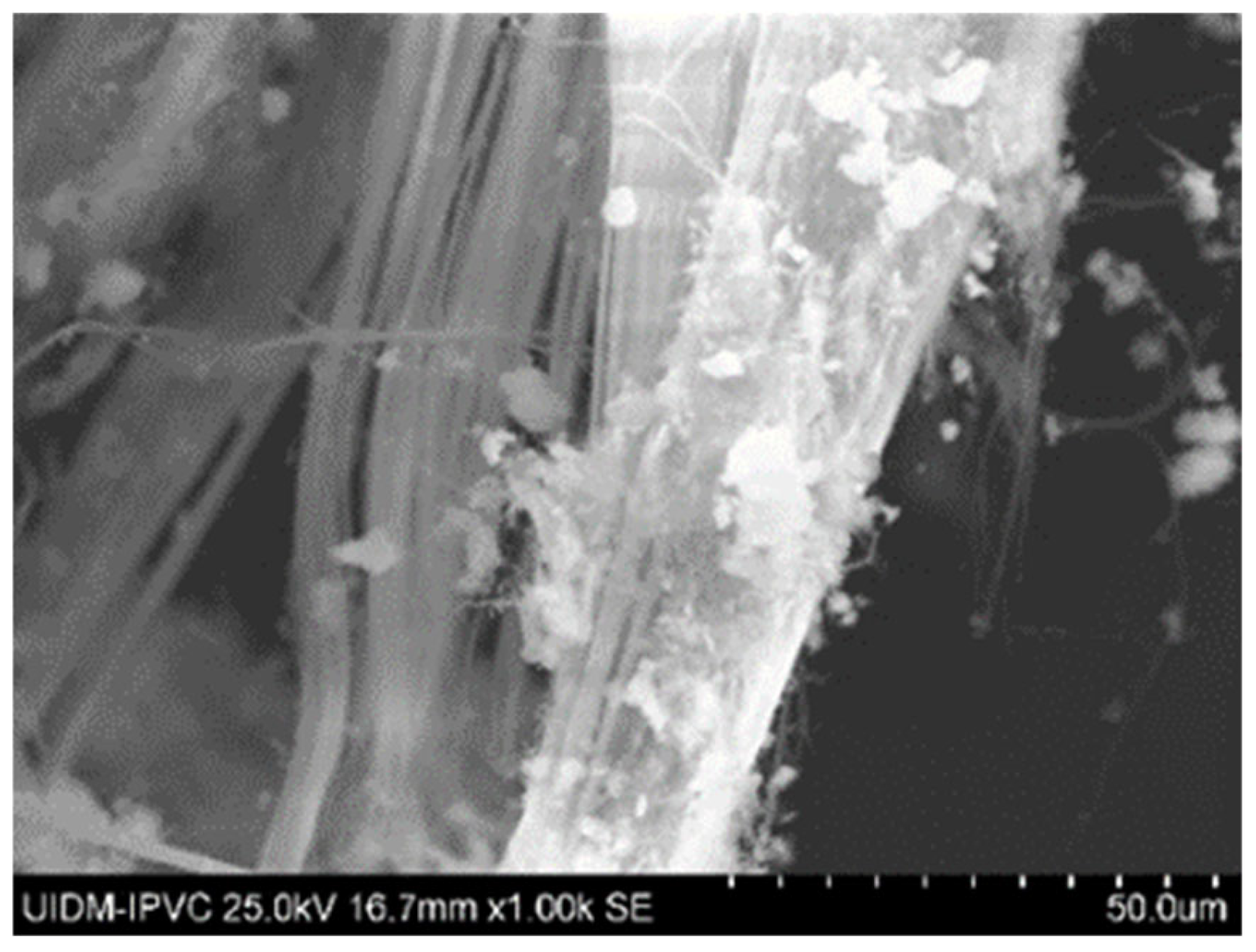
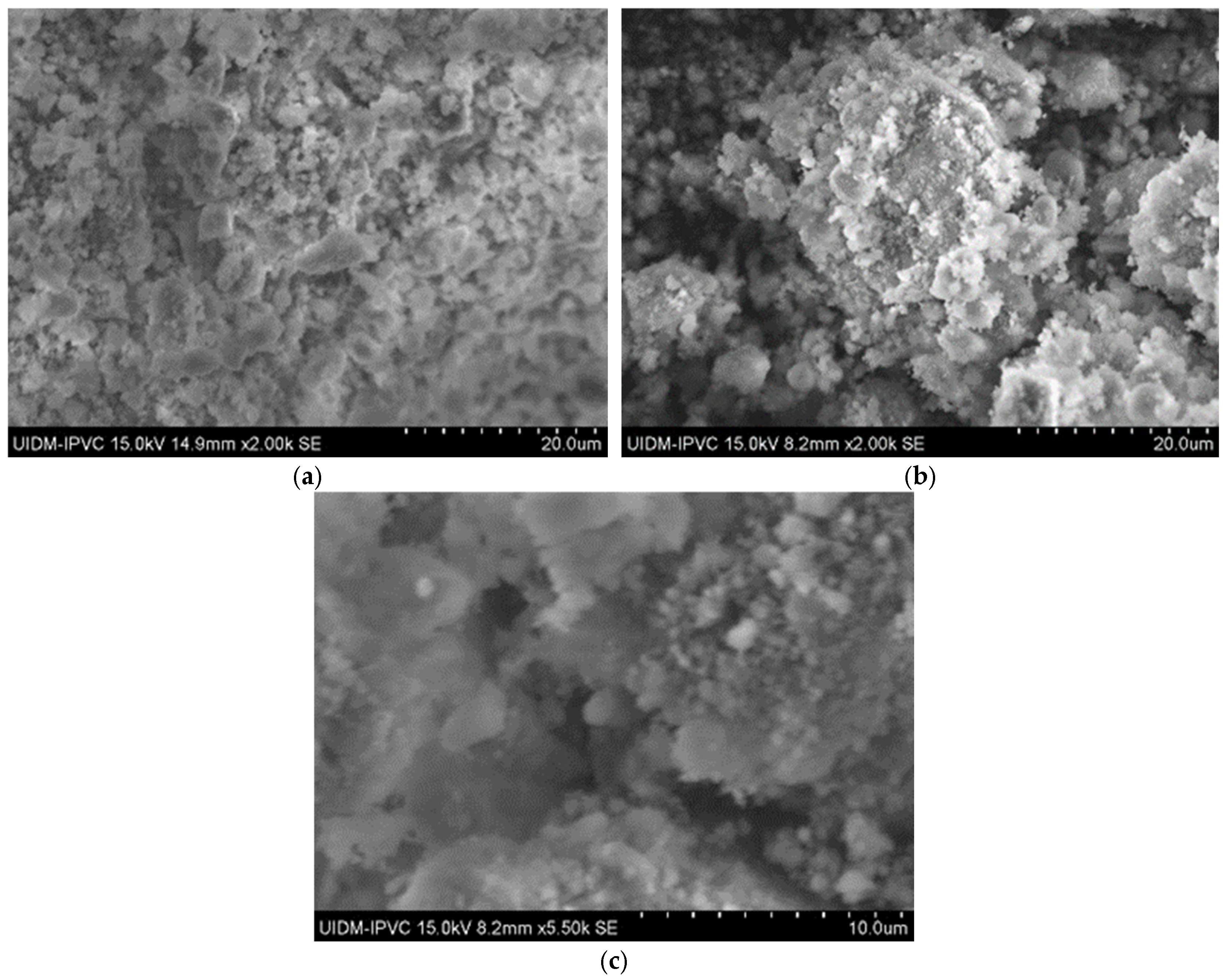

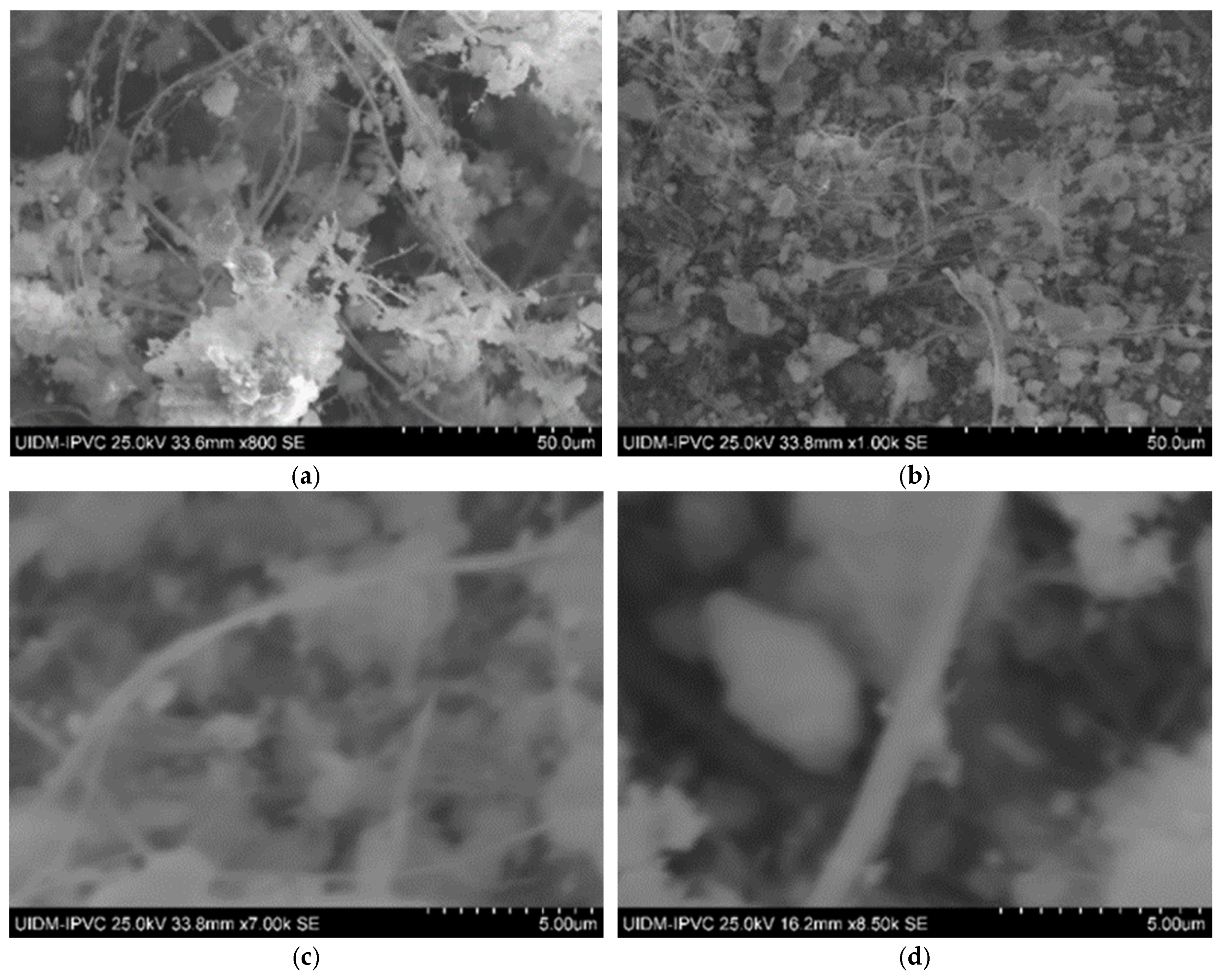


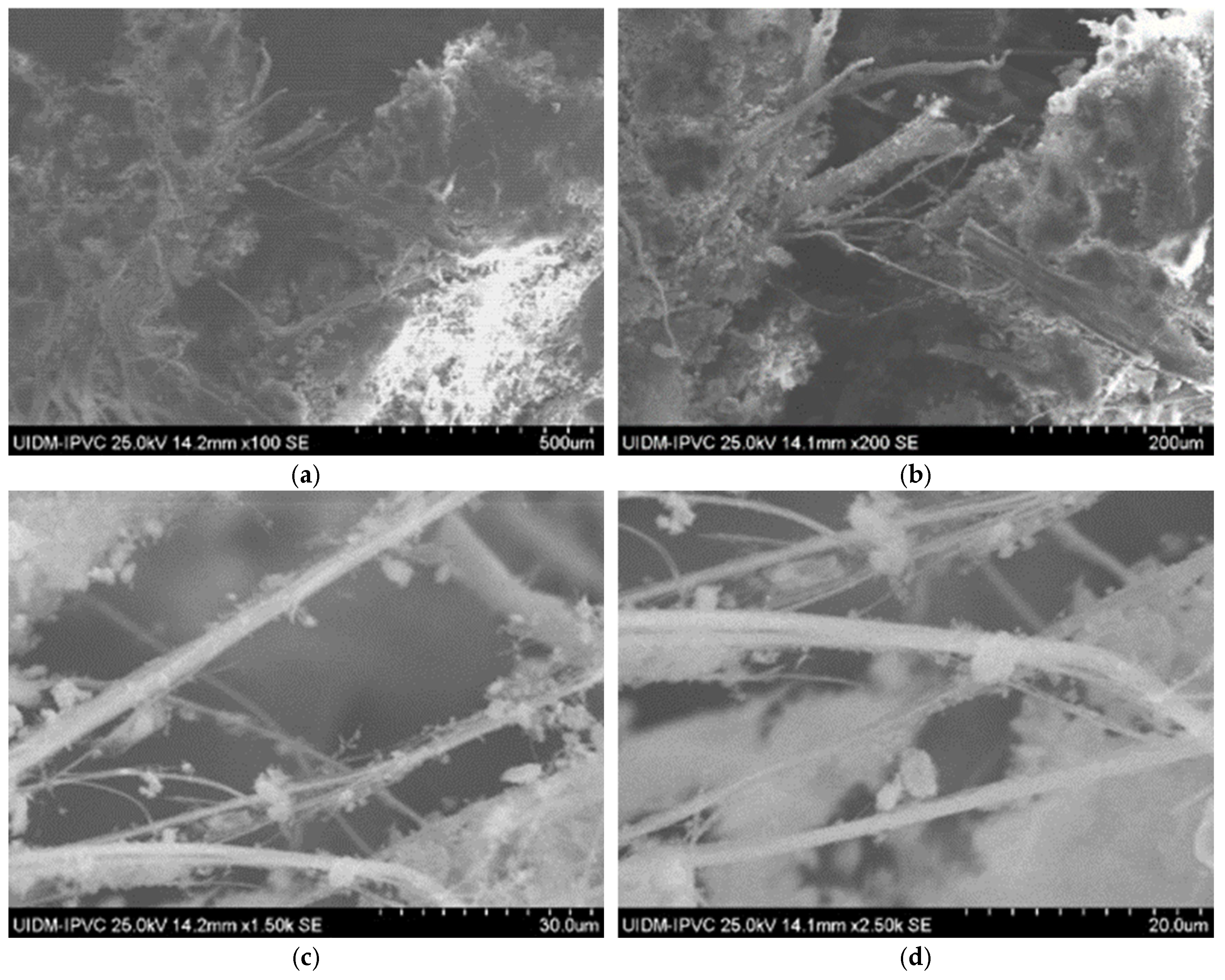
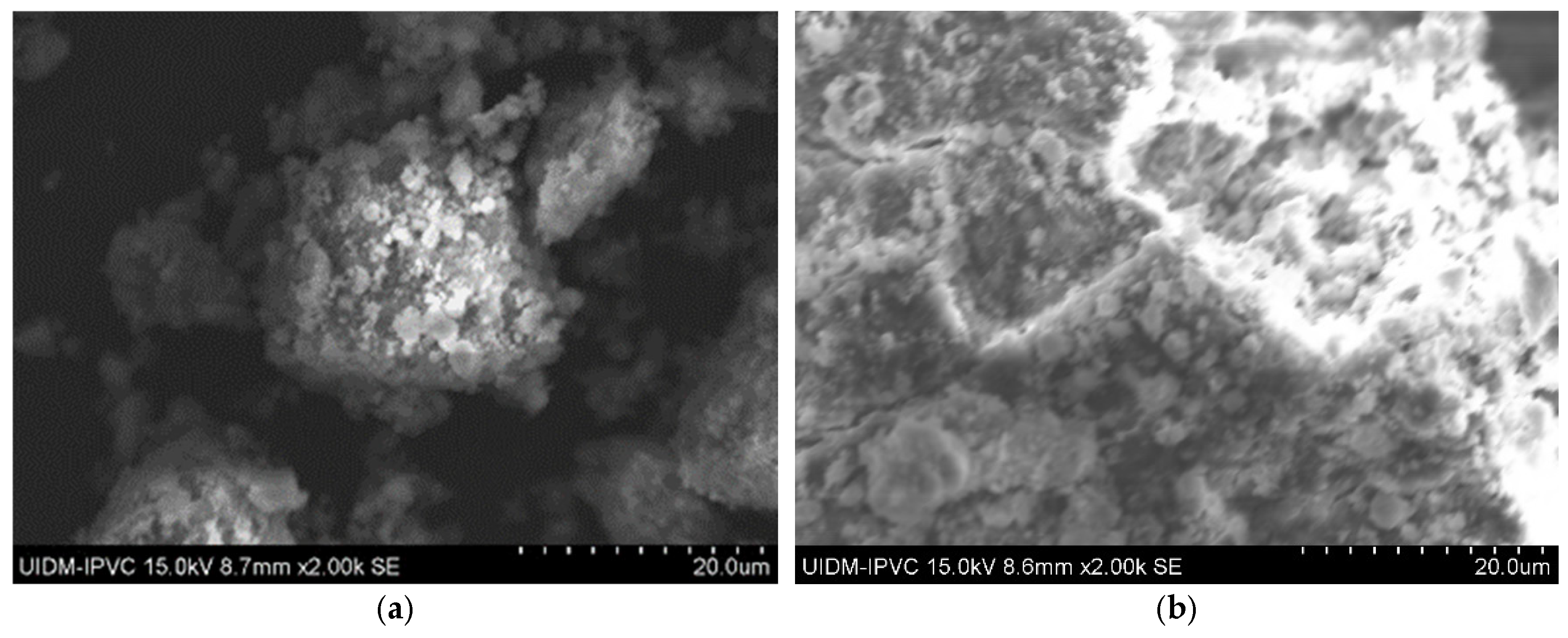
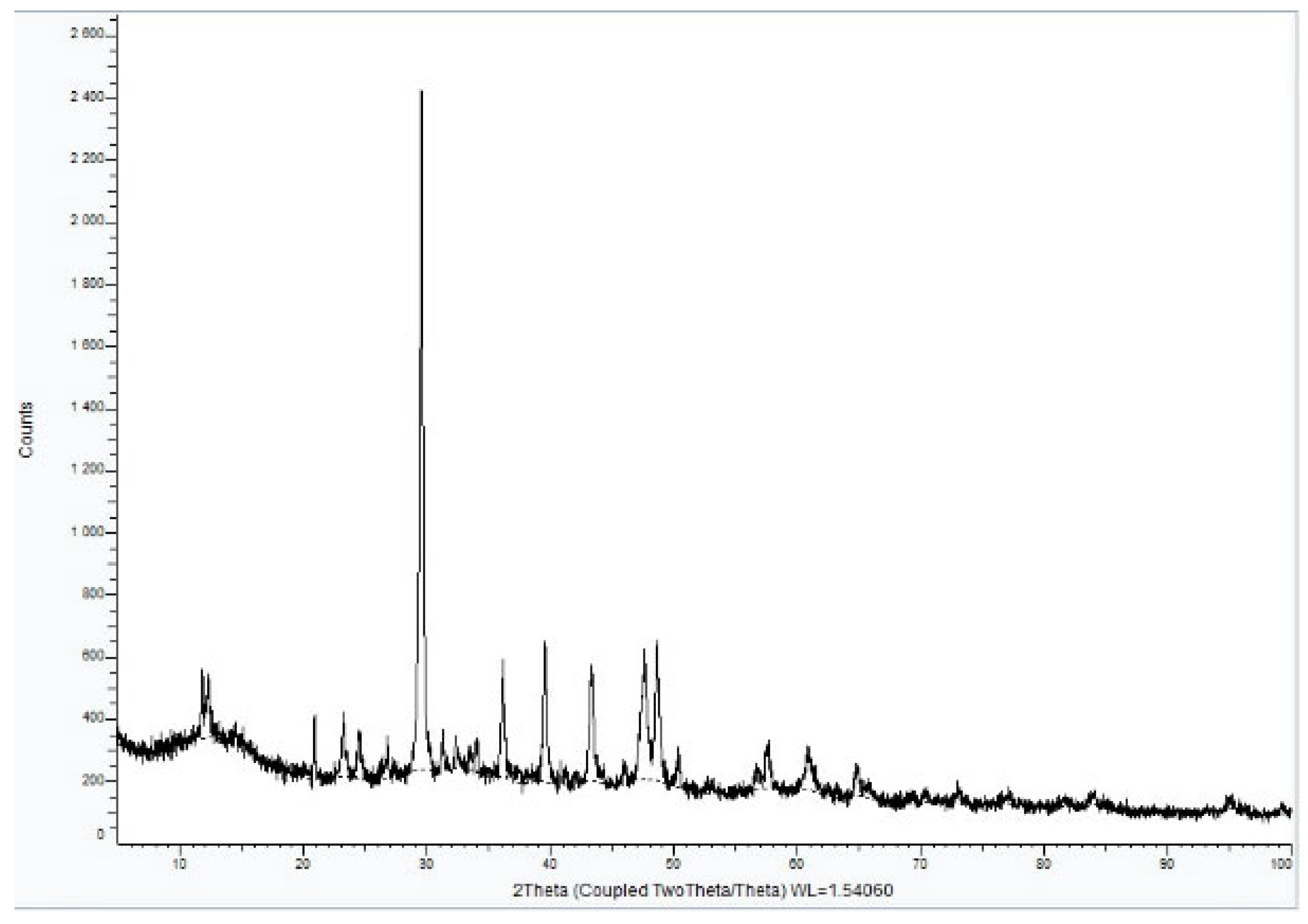

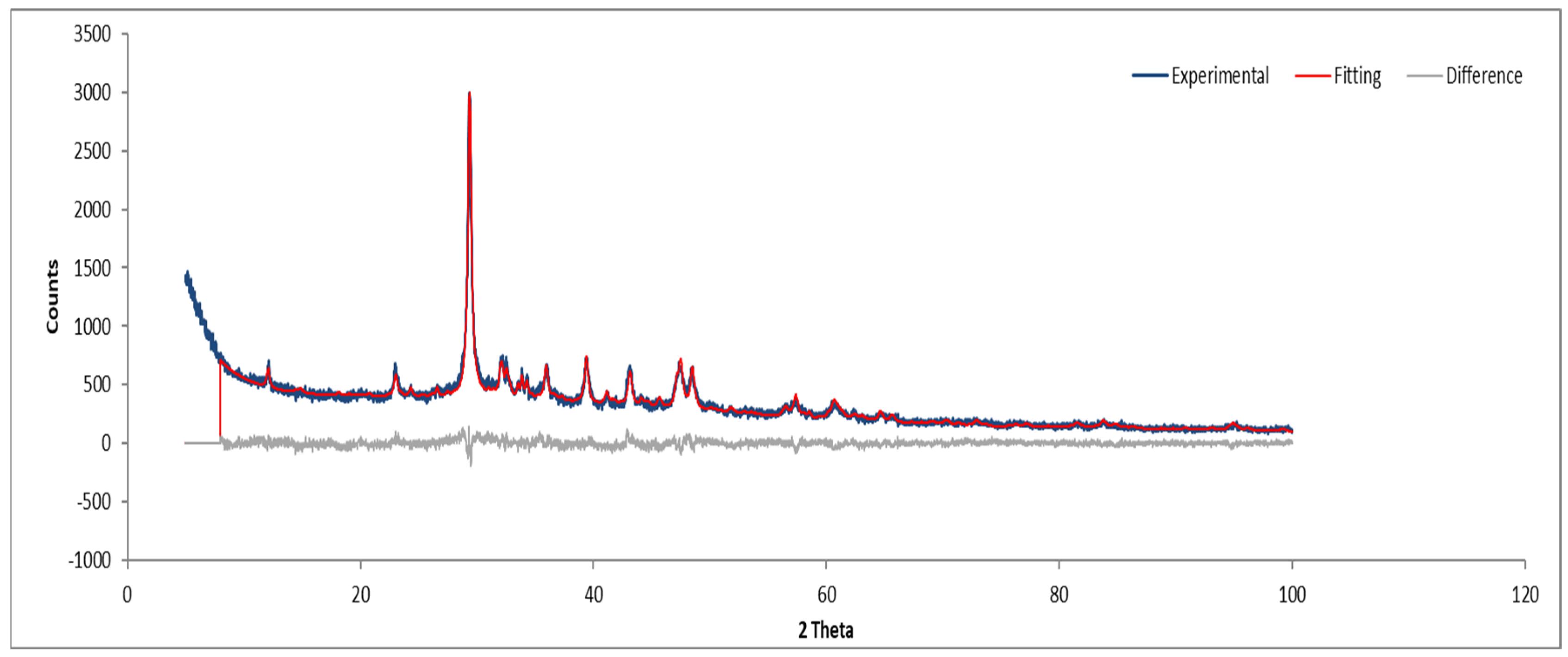

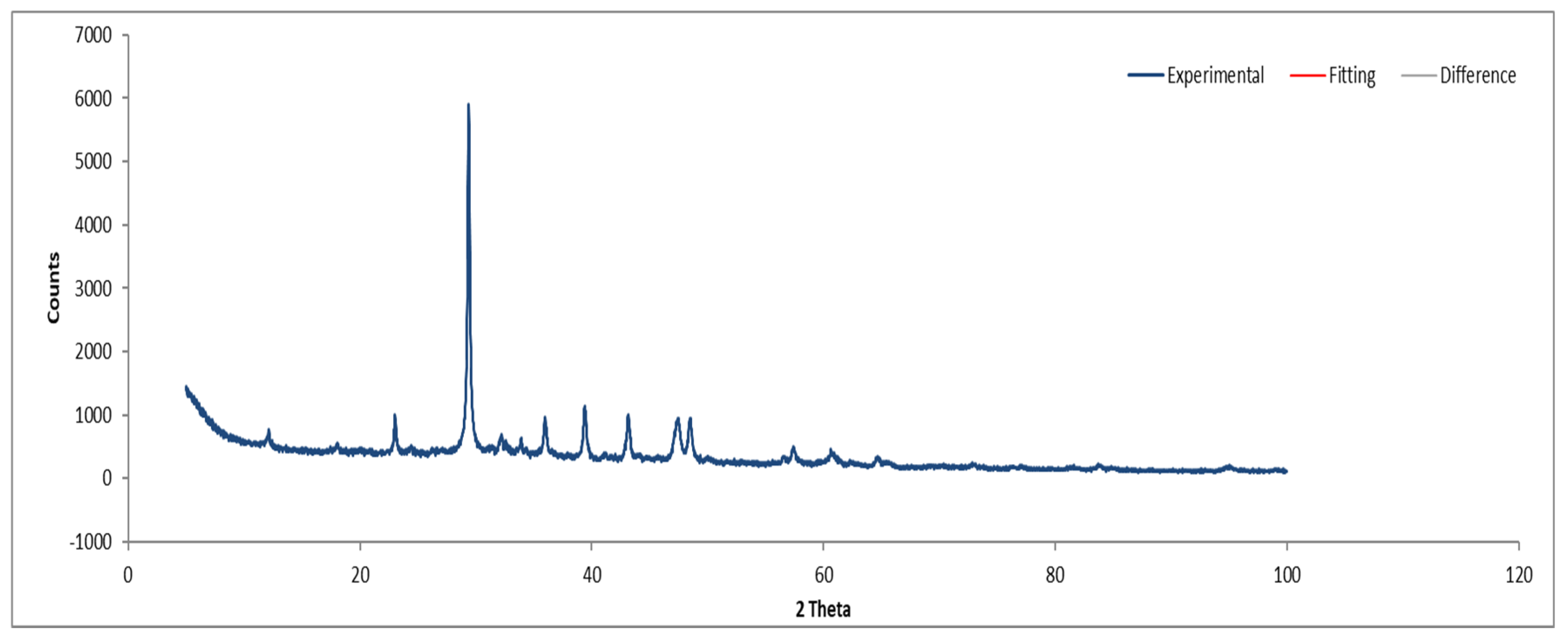
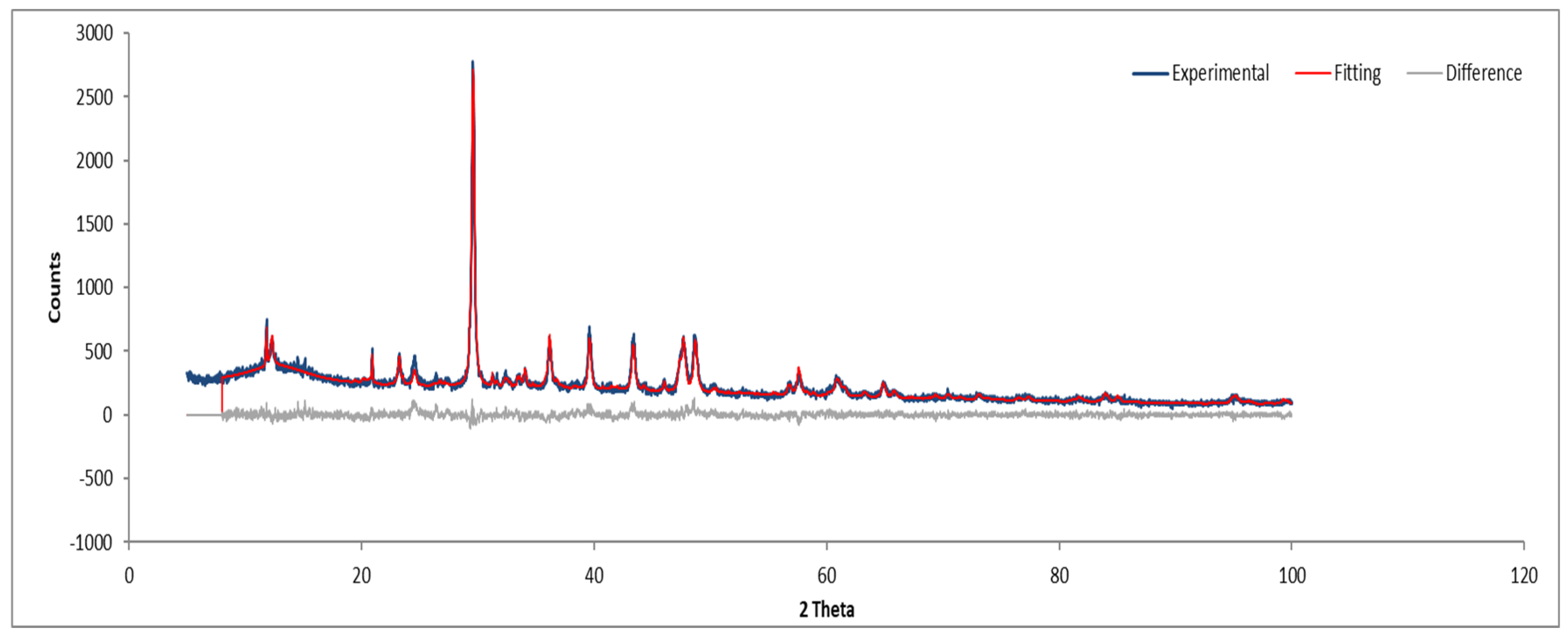

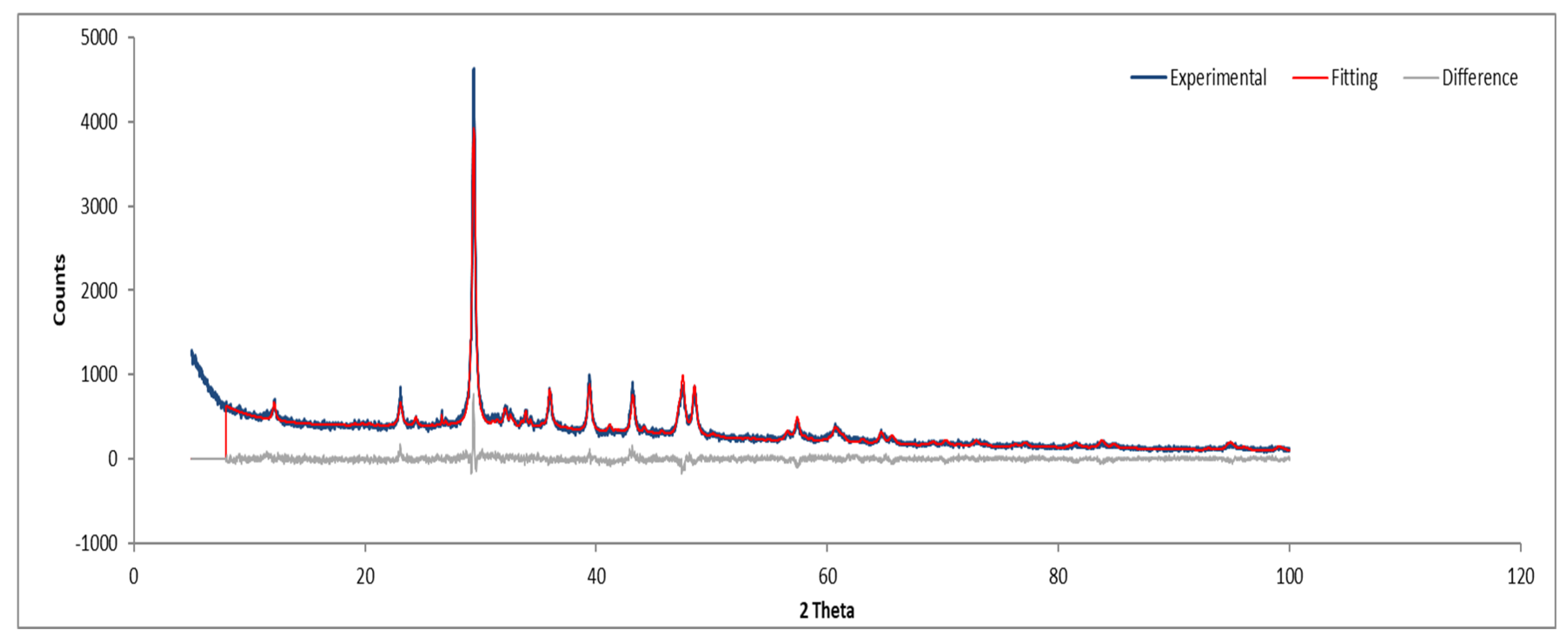
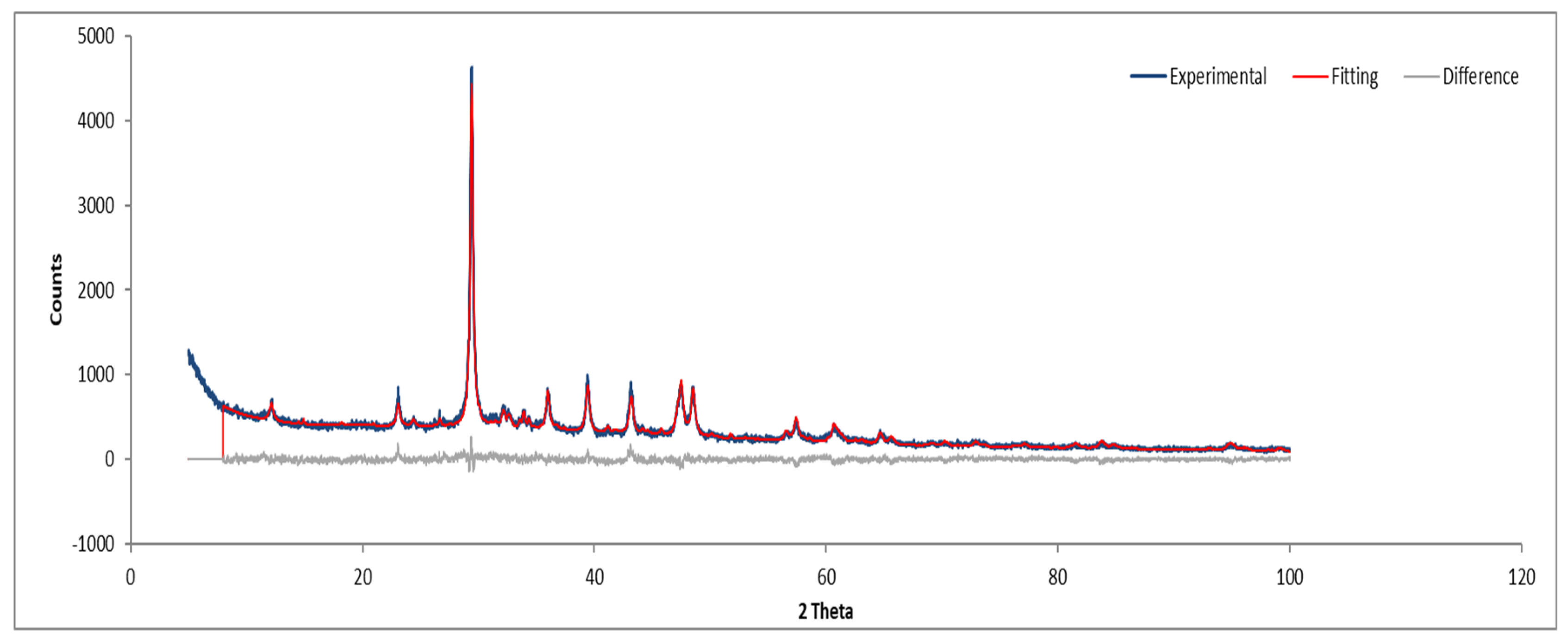
| Sample | Chrysotile Content (% by Mass) | Standard Deviation |
|---|---|---|
| A | 8.58 | 0.45 |
| B | 33.66 | 1.12 |
| C | 11.60 | 0.67 |
| D | 5.14 | 0.33 |
| Sample | D10 (µm) | D50 (µm) | D90 (µm) |
|---|---|---|---|
| A | 5.2 | 32.5 | 68.3 |
| B | 4.8 | 30.8 | 66.7 |
| C | 5.5 | 34.2 | 70.1 |
| D | 4.9 | 31.4 | 67.9 |
| Powder Samples | Solid Fiber Samples | ||||||||
|---|---|---|---|---|---|---|---|---|---|
| A | B | C | D | A | B | C | D | ||
| C2S Beta Larnite | C2S Beta Larnite | 13.60 ± 0.52 | 5.76 ± 0.31 | 5.94 ± 0.28 | 7.23 ± 0.35 | 4.68 ± 0.22 | 13.97 ± 0.61 | 1.95 ± 0.15 | 9.12 ± 0.42 |
| C3S Alite M1 | C3S Alite M1 | 12.63 ± 0.48 | 3.24 ± 0.19 | 3.76 ± 0.21 | 4.24 ± 0.23 | 2.64 ± 0.17 | |||
| C4AF Al Ca2 Fe O5 | C4AF Al Ca2 Fe O5 | 5.19 ± 0.27 | 4.35 ± 0.24 | 4.68 ± 0.25 | 4.70 ± 0.26 | 6.23 ± 0.29 | 0.22 ± 0.05 | 5.89 ± 0.30 | 4.31 ± 0.22 |
| Calcite, syn | Calcite, syn | 61.50 ± 1.82 | 79.78 ± 2.11 | 77.45 ± 1.95 | 75.71 ± 1.88 | 72.71 ± 1.76 | 17.13 ± 0.92 | 74.05 ± 1.80 | 79.92 ± 1.91 |
| Gypsum | Gypsum | 4.98 ± 0.31 | 4.21 ± 0.28 | ||||||
| Portlandite, syn | Portlandite, syn | 32.39 ± 1.45 | |||||||
| Quartz, low | Quartz, low | 0.97 ± 0.08 | 0.55 ± 0.06 | 0.90 ± 0.07 | 1.04 ± 0.09 | 1.33 ± 0.10 | 0.52 ± 0.05 | 0.55 ± 0.06 | |
| Magnesium Silicate Hydroxide | Clinochrysotile-2Mc1 | 6.11 ± 0.33 | 6.32 ± 0.34 | 7.26 ± 0.36 | 7.08 ± 0.35 | 8.58 ± 0.45 | 33.66 ± 1.12 | 11.60 ± 0.67 | 5.14 ± 0.33 |
| Graphite | Graphite | 1.48 ± 0.12 | 1.28 ± 0.11 | 0.96 ± 0.09 | |||||
| Iron Silicon | Iron Silicon | 0.50 ± 0.04 | |||||||
| 100 | 100 | 100 | 100 | 100 | 100 | 100 | 100 | ||
Disclaimer/Publisher’s Note: The statements, opinions and data contained in all publications are solely those of the individual author(s) and contributor(s) and not of MDPI and/or the editor(s). MDPI and/or the editor(s) disclaim responsibility for any injury to people or property resulting from any ideas, methods, instructions or products referred to in the content. |
© 2025 by the authors. Licensee MDPI, Basel, Switzerland. This article is an open access article distributed under the terms and conditions of the Creative Commons Attribution (CC BY) license (https://creativecommons.org/licenses/by/4.0/).
Share and Cite
Curado, A.; Nunes, L.J.R.; Carvalho, A.; Abrantes, J.; Lima, E.; Tomé, M. Recovery of End-of-Life Building Materials: Thermal Decomposition and Phase Transformation of Chrysotile in Asbestos-Containing Fiber Cement Boards. Fibers 2025, 13, 62. https://doi.org/10.3390/fib13050062
Curado A, Nunes LJR, Carvalho A, Abrantes J, Lima E, Tomé M. Recovery of End-of-Life Building Materials: Thermal Decomposition and Phase Transformation of Chrysotile in Asbestos-Containing Fiber Cement Boards. Fibers. 2025; 13(5):62. https://doi.org/10.3390/fib13050062
Chicago/Turabian StyleCurado, António, Leonel J. R. Nunes, Arlete Carvalho, João Abrantes, Eduarda Lima, and Mário Tomé. 2025. "Recovery of End-of-Life Building Materials: Thermal Decomposition and Phase Transformation of Chrysotile in Asbestos-Containing Fiber Cement Boards" Fibers 13, no. 5: 62. https://doi.org/10.3390/fib13050062
APA StyleCurado, A., Nunes, L. J. R., Carvalho, A., Abrantes, J., Lima, E., & Tomé, M. (2025). Recovery of End-of-Life Building Materials: Thermal Decomposition and Phase Transformation of Chrysotile in Asbestos-Containing Fiber Cement Boards. Fibers, 13(5), 62. https://doi.org/10.3390/fib13050062








